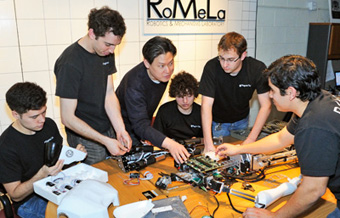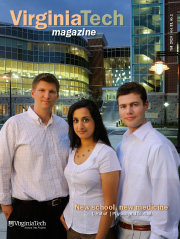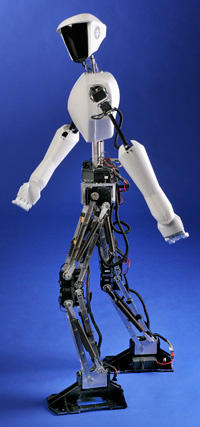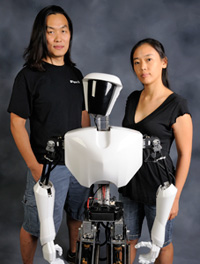 |
|
||||||
|
|
||||||||||||||||||||||||||||||||||||||||||||||||||||||||||||||||||||||||||||||||||||||||||
|
CHARLI in charge
CHARLI--the first, full-sized autonomous walking humanoid robot built inside the United States--has gone over the moon with the robotics world. He introduced a "Cool Jobs" panel featuring Hong at the 2010 World Science Festival in New York; wowed thousands of spectators at Hong Kong's 350,000-square-foot Park Central Mall; made a splash debut at the 2010 Singapore RoboCup Tournament, winning third in his division; and landed on the August cover of Popular Science. Not bad for a 5-month-old. There's been a hiccup along the way, as to be expected with breaking-edge technology: CHARLI popped the main balance sensor in Singapore and crashed to the ground after becoming disoriented. But that won't stop him--and Virginia Tech--from helping lead the way in robotics research in the United States.
The students at Virginia Tech's Robotics and Mechanisms Laboratory (RoMeLa) have built some cool robots in the past several years, and CHARLI is by far the tops. But cool goes only so far. And CHARLI is much more. Jeakweon "J.K". Han, CHARLI's main architect and a doctoral student from Seoul, Korea, always has seen robots as helpful. "When I was a young child in Korea, I was always watching 'Astro Boy' on TV, a show about this heroic robot helping and protecting people," he said. "I want people to accept robots as their companions, not as a 'Terminator.'" Dennis Hong, director of RoMeLa, sees future incarnations for CHARLI as necessary to everyday life. Eventually, CHARLIs could help care for elderly parents or perform jobs too dangerous for people, such as fighting fires on naval ships. The U.S. Navy is expected this fall to give RoMeLa $3 million to continue building CHARLI-H (as in Heavyweight), a robot able to navigate complex surroundings and endure harsh conditions. Work is also under way on CHARLI-L2 (L for Lightweight), an improved version of the first. CHARLI is proof, yet again, of Hong's and RoMeLa's leadership in U.S. robotics research. Worldwide, the field is dominated by South Korea and Japan. In a recent Popular Science cover story on robotics, editors dubbed CHARLI "the loneliest humanoid in America." Hong hopes to openly compete with these robotic superpowers with ingenuity as his rocket. "CHARLI-L is just the start, to quickly get our foot into this exclusive international club of humanoid robots," Hong said. "Though we still have a long way to go to catch up, RoMeLa always approaches the problem in fresh, new, innovative ways, and we believe we can create new solutions that can leapfrog the 'traditional' approaches." Hong is convinced the team's work will impact the world for the better. "We are not just doing this for the fun of it," Hong said. "Our goal is to develop new technology to benefit society and to teach the next generation of engineers who will become the leaders in their fields."
|
|
|||||||||||||||||||||||||||||||||||||||||||||||||||||||||||||||||||||||||||||||||||||||||
|
|




